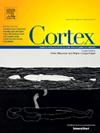颞上回和颞上回语音包络跟踪响应的线性相位特性
IF 3.3
2区 心理学
Q1 BEHAVIORAL SCIENCES
引用次数: 0
摘要
理解大脑在听的过程中是如何追踪语言的仍然是一个挑战。相位重置假说认为,包络跟踪响应是通过重置固有的非线性神经振荡的相位而产生的,而诱发反应假说认为,包络跟踪响应是由语音中一系列声学事件引起的瞬态响应的线性叠加。最近的研究已经证明了包络跟踪响应的线性相位特性,支持诱发反应假说。然而,与诱发反应假说一致的皮层区域仍不清楚。为了解决这个问题,我们使用立体脑电图(SEEG)直接记录了19名癫痫患者在听自然语言时的皮层,并研究了语音包络和神经活动之间的相位滞后是否随频率线性变化。我们发现低频(LF)的线性相位特性。在颞上回(STG)和颞上回(HG)中广泛观察到包络跟踪,在脑岛、中央后回和中央前回中分布较少。此外,从相位-频率曲线得到的LF包络跟踪反应潜伏期沿HG和STG后-前方向呈梯度增加,表明听觉皮层可以跟踪言语包络,这符合诱发反应假说。本文章由计算机程序翻译,如有差异,请以英文原文为准。
Linear phase property of speech envelope tracking response in Heschl’s gyrus and superior temporal gyrus
Understanding how the brain tracks speech during listening remains a challenge. The phase resetting hypothesis proposes that the envelope-tracking response is generated by resetting the phase of intrinsic nonlinear neural oscillations, whereas the evoked response hypothesis proposes that the envelope-tracking response is the linear superposition of transient responses evoked by a sequence of acoustic events in speech. Recent studies have demonstrated a linear phase property of the envelope-tracking response, supporting the evoked response hypothesis. However, the cortical regions aligning with the evoked response hypothesis remain unclear. To address this question, we directly recorded from the cortex using stereo-electroencephalography (SEEG) in nineteen epilepsy patients as they listened to natural speech, and we investigated whether the phase lag between the speech envelope and neural activity linearly changes across frequency. We found that the linear phase property of low-frequency (LF) (.5–40 Hz) envelope tracking was widely observed in Heschl’s gyrus (HG) and superior temporal gyrus (STG), with additional sparser distribution in insula, postcentral gyrus, and precentral gyrus. Furthermore, the latency of LF envelope-tracking responses derived from phase–frequency curve exhibited an increase gradient along HG and in the posterior-to-anterior direction in STG. Our findings suggest that auditory cortex can track speech envelope in line with the evoked response hypothesis.
求助全文
通过发布文献求助,成功后即可免费获取论文全文。
去求助
来源期刊

Cortex
医学-行为科学
CiteScore
7.00
自引率
5.60%
发文量
250
审稿时长
74 days
期刊介绍:
CORTEX is an international journal devoted to the study of cognition and of the relationship between the nervous system and mental processes, particularly as these are reflected in the behaviour of patients with acquired brain lesions, normal volunteers, children with typical and atypical development, and in the activation of brain regions and systems as recorded by functional neuroimaging techniques. It was founded in 1964 by Ennio De Renzi.
 求助内容:
求助内容: 应助结果提醒方式:
应助结果提醒方式:


